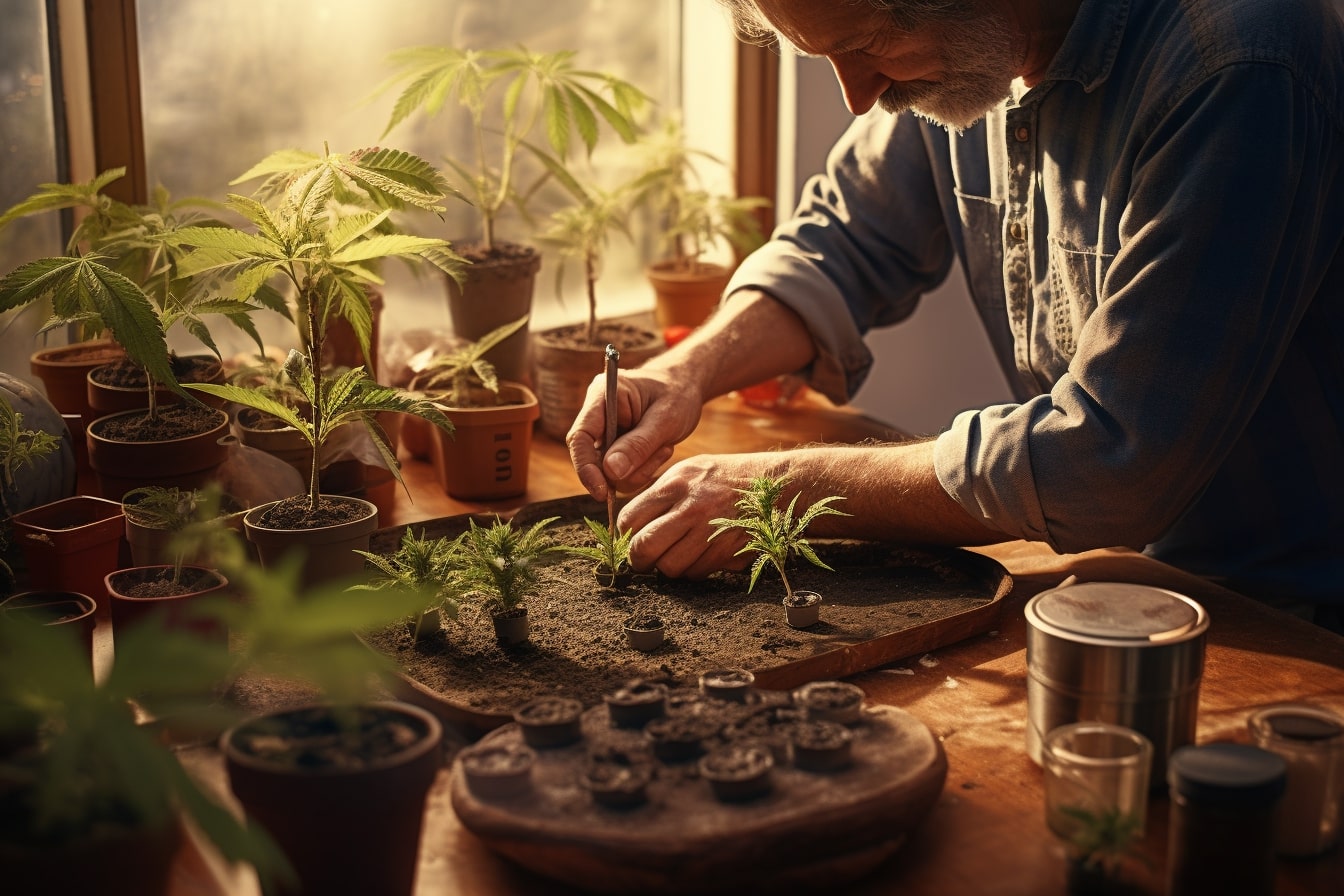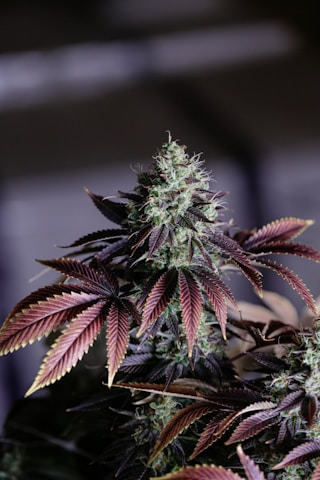
As a seasoned grower, Johnny Ganja understands the ins and outs of indoor cannabis cultivation. In this guide, you’ll find essential tips and techniques to help your plants thrive in an indoor environment. Let’s dive in and start your journey towards a successful and bountiful harvest!
Choosing the Right Cannabis Seeds
It all starts with the seeds. To grow top-quality cannabis, you must first understand the differences between indica, sativa, and hybrid strains. Indica strains typically produce relaxing effects, while sativa strains tend to be more uplifting and energetic. Hybrids offer a mix of characteristics from both parent strains.
Several factors come into play when selecting seeds. These include THC content, growing difficulty, and yield. Consider your personal preferences, experience level, and available resources when making your decision. Keep in mind that some strains are more suited for indoor cultivation than others.
Lastly, always purchase your seeds from a reputable seed bank. This ensures you receive high-quality, genetically stable seeds that will produce the desired results. Trustworthy seed banks, like Johnny Ganja’s, offer a wide variety of top-tier seeds and provide exceptional customer service to ensure your growing success.
Setting Up Your Indoor Grow Space
Location matters. To set up your indoor grow space, choose an area that provides easy access, privacy, and enough room for your plants. Consider factors such as temperature, humidity, and noise levels. A well-thought-out space will make your growing experience more enjoyable and efficient.
There are various types of grow spaces to choose from, including grow tents, cabinets, and closets. Grow tents are popular due to their versatility, easy assembly, and ability to mimic ideal growing conditions. Cabinets and closets offer stealth and space-saving benefits, perfect for those with limited room or a desire for discretion.
Proper ventilation and air circulation are crucial for healthy plant growth. Ensure your grow space has an adequate exhaust system and intake vents for fresh air. This helps prevent mold, pests, and stagnant air. Strategically placed fans also encourage strong stem development and overall plant health.
Finally, it’s essential to manage odors in your grow space. Activated carbon filters and air purifiers can effectively eliminate cannabis aromas, keeping your indoor cultivation discreet and neighbor-friendly.
Lighting for Indoor Cannabis Growth
Light plays a critical role in cannabis cultivation. It influences plant growth, bud development, and potency. As an indoor grower, it’s essential to understand and provide the optimal lighting conditions for your plants.
There are several types of grow lights available, each with its pros and cons. High-Intensity Discharge (HID) lights, such as Metal Halide (MH) and High-Pressure Sodium (HPS), have been popular choices for years. They provide intense light and promote vigorous growth but can produce excess heat and consume more electricity. Compact Fluorescent Lights (CFLs) are energy-efficient and produce less heat, making them suitable for smaller grow spaces. However, they may not provide the same light intensity as HID lights. Light Emitting Diodes (LEDs) are a more recent addition to the grow light market. They offer energy efficiency, a full spectrum of light, and less heat output, but can be more expensive initially.
Choosing the right light schedule for your plants is crucial. Cannabis plants require varying light schedules during their vegetative and flowering stages. Typically, a 18/6 (18 hours on, 6 hours off) light schedule is used during the vegetative stage, while a 12/12 schedule is followed during the flowering stage. Monitoring and adjusting your light schedule ensures healthy growth and a bountiful harvest.
Read: Guide to LED lights for growing cannabis
Growing Medium and Nutrients
Selecting the right growing medium is essential for a successful cannabis grow. Popular options include soil, coco coir, and hydroponics. Soil is a traditional choice, providing a natural environment with organic nutrients. Coco coir, made from coconut husks, offers excellent water retention and aeration while being environmentally friendly. Hydroponics is a soilless method that allows for precise nutrient control and faster growth but may require more advanced knowledge and setup.
Providing the correct nutrients during each growth stage is crucial for cannabis plants. Nitrogen, phosphorus, and potassium (N-P-K) are the primary macronutrients required for healthy growth. Different ratios are needed during the vegetative and flowering stages, so be sure to adjust your nutrient feedings accordingly.
Maintaining proper pH levels is essential for nutrient absorption. Cannabis plants typically thrive at a pH of 6.0-6.5 in soil and 5.5-6.0 in hydroponics. Regularly test and adjust your pH levels to avoid nutrient deficiencies and imbalances. By carefully monitoring your growing medium and nutrients, you’ll ensure your plants receive everything they need to flourish.
Temperature and Humidity Control
Controlling temperature and humidity is vital for healthy cannabis growth. Ideal conditions vary depending on the growth stage. During the vegetative stage, maintain temperatures between 70-85°F (21-29°C) and relative humidity (RH) levels around 40-70%. In the flowering stage, temperatures should range from 65-80°F (18-26°C), with RH levels between 40-50%.
Invest in tools to monitor and control your grow environment. Thermometers, hygrometers, and environmental controllers help maintain consistent temperature and humidity levels. Air conditioners, heaters, dehumidifiers, and humidifiers can be used to make adjustments as needed.
Fluctuations in temperature and humidity can stress plants and lead to issues such as mold, pests, and slow growth. Address any significant changes swiftly to keep your plants healthy and thriving. By maintaining a stable environment, you’ll encourage optimal growth and a bountiful harvest.
Read: Managing your cannabis plant temperature
Watering and Feeding Your Cannabis Plants
Proper watering is crucial for healthy cannabis growth. Techniques and schedules may vary depending on factors such as the growing medium, plant size, and environmental conditions. Generally, it’s best to water your plants when the top inch of the growing medium feels dry. Avoid overwatering, as it can lead to root rot and other issues.
Recognize the signs of overwatering or underwatering your plants. Overwatered plants may exhibit drooping leaves, yellowing, and slow growth, while underwatered plants may have dry, crispy leaves and stunted growth. Adjust your watering schedule accordingly to ensure your plants receive the right amount of moisture.
Monitor your plants’ nutrient needs throughout their growth cycle. Adjust nutrient feedings based on factors such as growth stage, plant size, and observed deficiencies. By providing the right balance of water and nutrients, you’ll keep your cannabis plants healthy and thriving on their journey from seed to harvest.
Training Techniques for Maximum Yield
Training cannabis plants can significantly improve your yield and overall plant health. By manipulating growth patterns, you encourage more bud sites and better light penetration. This results in larger, more potent buds and a more even canopy.
Several popular training methods can be used to maximize your yield. Topping involves cutting the main stem, promoting the growth of multiple primary colas. Low-Stress Training (LST) gently bends and ties down branches, exposing more of the plant to light. The Screen of Green (ScrOG) method uses a horizontal screen to support and train the plants, creating an even canopy. Sea of Green (SoG) focuses on growing many small plants close together, shortening the vegetative stage and maximizing space.
Implementing these techniques effectively requires patience, practice, and observation. Start by choosing a method that best suits your grow space, resources, and skill level. Monitor your plants closely, making adjustments as needed to ensure they receive the optimal light exposure and support. With time and experience, you’ll master these techniques and enjoy impressive yields from your indoor cannabis grow.
Pest and Disease Prevention and Management
Keeping your cannabis plants healthy and pest-free is essential for a successful grow. Familiarize yourself with common pests and diseases, such as spider mites, aphids, powdery mildew, and bud rot. Early identification and intervention can save your plants from irreversible damage.
Prevention is the best defense against pests and diseases. Keep your grow space clean, maintain proper environmental conditions, and inspect your plants regularly. Consider using natural pest deterrents, such as neem oil or diatomaceous earth, to keep potential invaders at bay.
Should an infestation or infection occur, act swiftly. Depending on the issue, you can choose from a variety of natural or chemical solutions to treat your plants. For example, insecticidal soap can help control mites and aphids, while fungicides can address powdery mildew and other fungal infections. Remember to follow treatment instructions carefully and monitor your plants for signs of recovery or worsening conditions. By being proactive and vigilant, you can protect your cannabis plants from pests and diseases, ensuring a bountiful harvest.
Harvesting, Drying, and Curing Your Cannabis
The moment you’ve been waiting for – harvest time. Determining the optimal time for harvesting is crucial for maximizing potency and flavor. Monitor your plants’ trichomes, the tiny resin glands on the buds. When most trichomes appear milky white with a few amber ones, it’s time to harvest.
Proper techniques for cutting, drying, and curing your buds are essential for preserving their quality. Cut your plants at the base, trim off large fan leaves, and hang them upside-down in a cool, dark space with good airflow. Dry your buds for 7-14 days, depending on humidity levels, until the stems snap when bent.
Once your buds are dry, it’s time to cure them. Place your buds in airtight containers, such as glass jars, filling them about ¾ full. Store the containers in a cool, dark place and open them daily for the first week to release moisture and replenish oxygen. This process, known as “burping,” helps prevent mold and enhances the buds’ flavor and potency. Continue curing for at least 2-4 weeks, with some strains benefiting from even longer curing times. By following these steps, you’ll be rewarded with potent, flavorful cannabis to enjoy and share.
Conclusion
In this guide, we’ve covered essential topics for successful indoor cannabis cultivation. From selecting the right seeds and setting up your grow space to mastering training techniques and harvesting your buds, these tips will set you on the path to a thriving cannabis garden.
Remember that growing cannabis is a learning process. Don’t be afraid to experiment, make mistakes, and adapt your techniques as you gain experience. Each grow is an opportunity to refine your skills and deepen your understanding of this incredible plant.
We invite you to explore Johnny Ganja’s other resources and products for even more guidance and support in your cannabis cultivation journey. Our passion for cannabis and commitment to providing top-tier seeds and exceptional customer service make us your go-to source for all things cannabis. Together, let’s cultivate success and enjoy the fruits of our labor.







